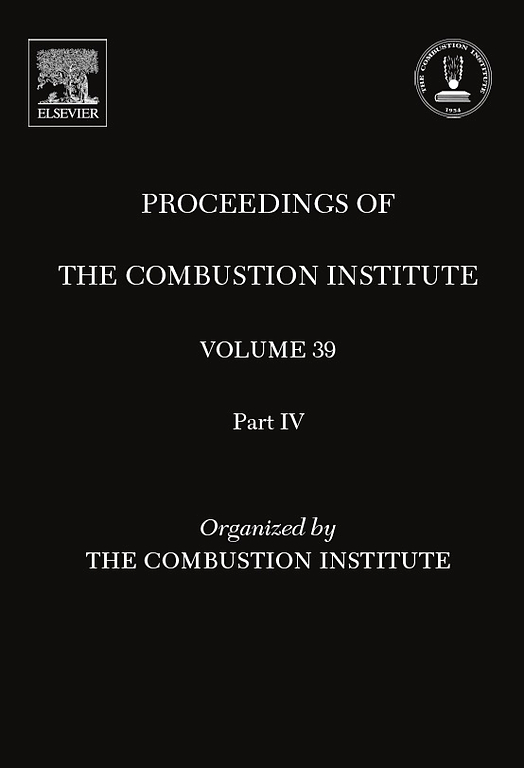Machine learning assisted characterisation and prediction of droplet distributions in a liquid jet in cross-flow
IF 5.2
2区 工程技术
Q2 ENERGY & FUELS
引用次数: 0
Abstract
In this paper, an artificial neural network (ANN) is trained with large eddy simulation (LES) data to predict the droplet size distribution (DSD) from the primary atomisation of a liquid jet in gaseous cross-flow (JIC), in terms of the Weber number (), momentum flux ratio () and density ratio. The JIC is simulated considering three (250, 500, 1000), (1, 5, 10), and density ratios (10, 100, 1000), respectively. The accuracy of the simulations is enhanced by including the injector geometry as well. The training data are obtained using LES with a stochastic fields transported-probability density function (PDF) method. We initially provide a physical analysis of the droplet distributions observed. We find that for lower density ratios, the resulting spray is mostly dominated by , influencing the main mechanisms governing the break-up process, which change the DSD shape. This dual mechanism is not present when increasing the density ratio. In the second part of the work, we build an ANN model (based on a multi-layered perceptron) using the DSDs from the LES as a train-and-test dataset, to predict at the end the full DSD for the JIC given as input the three non-dimensional parameters. The DSD from the trained ANN is found to be a good fit for the range investigated, predicting both the stochastic nature and change in shape of the droplet populations upon varying the input parameters. The developed model is intended to enhance future simulations of secondary atomisation in Eulerian-Lagrangian frameworks by providing the initial DSDs.机器学习辅助表征和预测横流液体射流中的液滴分布
本文利用大涡模拟(LES)数据训练了一个人工神经网络(ANN),从韦伯数()、动量通量比()和密度比的角度预测气态横流(JIC)中液体射流一次雾化的液滴粒度分布(DSD)。模拟 JIC 时分别考虑了三个(250、500、1000)、(1、5、10)和密度比(10、100、1000)。通过将喷射器的几何形状也考虑在内,提高了模拟的准确性。训练数据是通过采用随机场传输概率密度函数 (PDF) 方法的 LES 获得的。我们首先对观察到的液滴分布进行了物理分析。我们发现,在密度比较低的情况下,所产生的喷雾主要是由"...... "主导,影响着改变液滴分布形状的主要破裂机制。当密度比增加时,这种双重机制就不存在了。在工作的第二部分,我们使用来自 LES 的 DSD 作为训练和测试数据集,建立了一个 ANN 模型(基于多层感知器),在输入三个非维度参数的情况下,最终预测 JIC 的完整 DSD。结果发现,经过训练的 ANN 所得出的 DSD 与所研究的范围非常吻合,既能预测液滴群的随机性,又能预测输入参数变化时液滴群形状的变化。所开发的模型旨在通过提供初始 DSD 增强未来欧拉-拉格朗日框架中二次雾化的模拟。
本文章由计算机程序翻译,如有差异,请以英文原文为准。
求助全文
约1分钟内获得全文
求助全文
来源期刊

Proceedings of the Combustion Institute
工程技术-工程:化工
CiteScore
7.00
自引率
0.00%
发文量
420
审稿时长
3.0 months
期刊介绍:
The Proceedings of the Combustion Institute contains forefront contributions in fundamentals and applications of combustion science. For more than 50 years, the Combustion Institute has served as the peak international society for dissemination of scientific and technical research in the combustion field. In addition to author submissions, the Proceedings of the Combustion Institute includes the Institute''s prestigious invited strategic and topical reviews that represent indispensable resources for emergent research in the field. All papers are subjected to rigorous peer review.
Research papers and invited topical reviews; Reaction Kinetics; Soot, PAH, and other large molecules; Diagnostics; Laminar Flames; Turbulent Flames; Heterogeneous Combustion; Spray and Droplet Combustion; Detonations, Explosions & Supersonic Combustion; Fire Research; Stationary Combustion Systems; IC Engine and Gas Turbine Combustion; New Technology Concepts
The electronic version of Proceedings of the Combustion Institute contains supplemental material such as reaction mechanisms, illustrating movies, and other data.
 求助内容:
求助内容: 应助结果提醒方式:
应助结果提醒方式:


